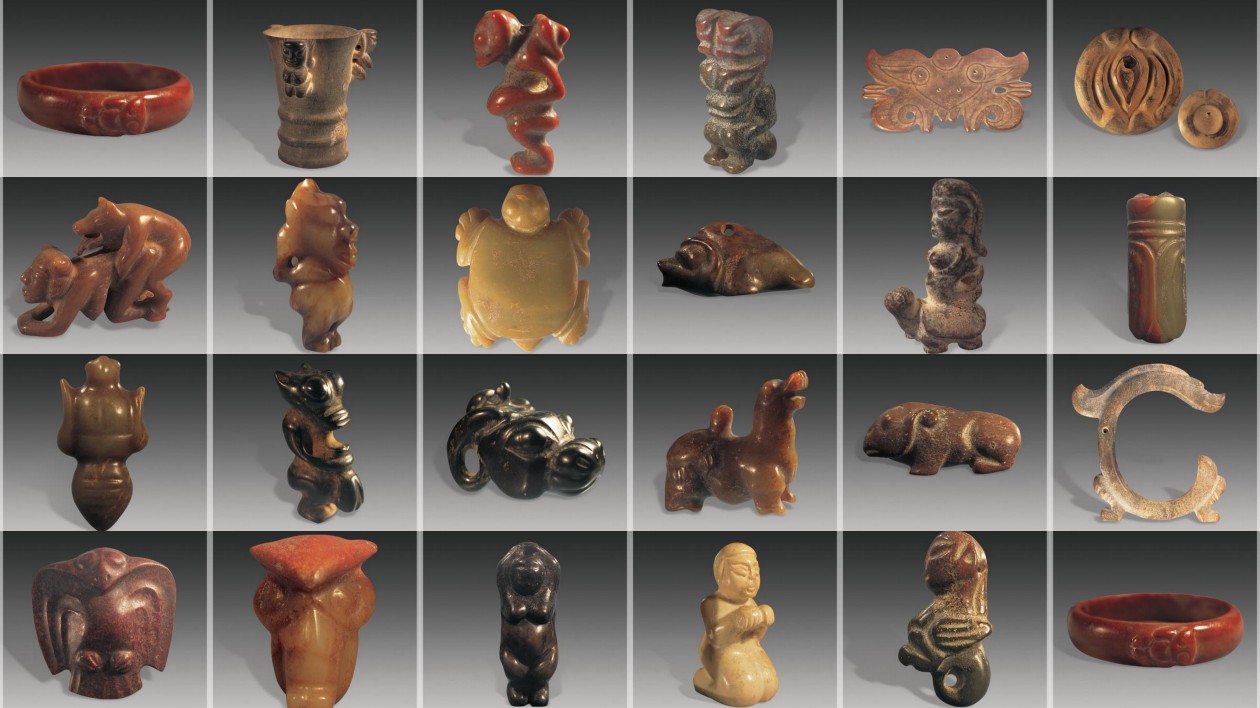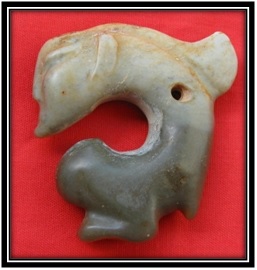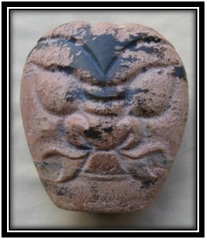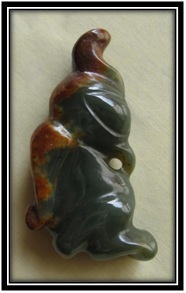四.野兽和家畜
泛红山文化玉群中的多种野兽和家畜地造型为我们提供了许多重要的文化信息。如当时的生态环境;人们的生产和生活方式;宗教信仰以及氏族的成分等。泛红山文化玉群中野兽的造型很多,家畜以牛、羊、猪为主。由此我们知道当时该地区的生态环境很好,适合多种鸟、兽类的生存。人们当时是以农、牧业为主,兼有狩猎的生产和生活方式,并且从多种动物的组合与融合造型可知当时的农、牧业氏族多以牛、羊、猪等为其氏族的图腾,可以推断,该地区是东夷族与羌族为主体的多氏族混居的地区。从多种动物的造型还可推知,该地区与其他的文化区间有广泛的文化交流。
4. Wild animals and livestock
A variety modeling of wild animals and domestic animals in the Pan-Hongshan cultural jade group provides us with much important cultural information, such as ecological environment; people’ production and life; religious and clan ingredients and so on. Among the Pan-Hongshan cultural jade group, there are many kinds of wild animals; the cattle, sheep and pig were the common livestock. From this we know that a good ecological environment in this region for a variety of birds and mammals survive. At that time, the people’s production and life were mainly based on agriculture, animal husbandry and hunting; and from the modeling of the combination and integration of a variety animals, we know that the agriculture and animal husbandry clans were commonly with cattle, sheep and pig as their clan’s totem. We can infer that this region was a mixed area of clans, the main clans were Dong-Yi and Qiang, and they had broad cultural exchange with other regions.
—
Fig4.1
4.1 猪
长6.8厘米,高3.4厘米,厚2.1厘米。
灰绿色翠玉,棕黄沁色。
造型为一立姿猪,其头型较大,水滴状双目高凸,鼻口部前噘,双耳立于脑后。前肢较短,后肢屈蹲。体形壮硕。其胸部有一对钻隧孔。猪是豕韦氏族图腾,在新石器时期豕韦氏分布很广,主要分布在东北地区与东部沿海地区,他们对红山文化与良渚文化的创建均有重要贡献。
4.1 Pig
Length: 6.8cm, high: 3.4cm, thickness: 2.1cm.
The jade is a kind of pyroxene in gray-green color with brown markings.
The pig is in standing position; it has a big head, drop-shaped convex eyes, the muzzle pouted, ears standing on the back of its head, the front legs short and the hind legs squatting, and sturdy body. There is a double bevel drilling hole on its chest.
The pig is the totem of the Shiwei’s clan which widely distributed, mainly in the Northeast China and the Chinese eastern coastal area in the New Stone Age. They had important contribution for creating the Hongshan culture and Liangzhu culture.
—
Fig 4.2
高3.5cm,宽4cm,厚1.1cm。
青玉,有灰斑及棕红沁色。
造型为一水牛头。头上双角上弯,尖端分别指向左右。枣核形双目突起,鼻口前噘。背面有两道纵向瓦沟纹,在其顶端有一对钻牛鼻穿。刀法简练,造型神似。
1996年12月辽宁省新民市附近挖掘出一架完整的水牛角化石,经专家鉴定,确认为其时间是距今一万年左右的更新世晚期。考古专家认为,这一发现对研究辽宁第四纪冰期的古气侯、古环境具有重要意义。这发现也证实笔者在前言中所讲的末次冰期晚期泛红山文化地区曾有很好的自然生态环境。泛红山玉群中出现水牛头的造型也不足为奇了。
4.2. Buffalo head
High: 3.5cm, width: 4cm, thickness: 1.1cm.
The jade is sapphire with reddish brown markings and gray spots.
Its shape is: the double horns bended upward, the horn tips pointed to right and left respectively; date kernel-shaped protruding eyes, muzzle pouted. . On the back of it, there is a longitudinal ridge and an ox nostril-shaped drilling hole on its top. This buffalo head model has concise carving techniques and vivid style.
December 1996, near the Xinmin county, Liaoning Province excavated a complete fossil of buffalo horn, by experts confirmed that its time is about ten thousand years ago, the Late Pleistocene. Archaeologists believed that this discovery has great significance for studying the ancient environment during the last ice age in that area. This discovery was also confirmed that it has a good natural and ecological environment in the Pan-Hongshan cultural area at that time.
—
Fig4.3
长6cm,高5cm,宽2.8cm。
青玉,玉质莹润,有灰皮及棕红沁色。
其造型为一河马背驮一海龟。河马体型壮硕,胸、腹部隆起,四肢较短,腿部肌肉发达;仰首,双目呈半球状突起,鼻翼高突,张口,好像在与海龟谈话。海龟头高抬,双目圆凸,龟壳略呈圆形;三角形短尾贴于河马尾部上方;四只大足,每足三趾,紧抱于河马之身后。
整体造型生动、有趣。河马经常将是身体泡在水中,只有头、背露出水面,像一块大礁石,海龟正好爬上去晒太阳,成了河马的好朋友。河马生活于非洲,古埃及人曾尊它为河马女神(也即是母系社会的氏族图腾),海龟是轩辕氏族图腾,这一造型表明:以东北亚为中心的泛红山地区先民曾与非洲先民有过友好的往来。
4.3. Hippo and sea turtle combinative ornament
Length: 6cm, high: 5cm, width: 2.8cm.
The jade is sapphire with corrosive reddish brown markings.
The shape of the modeling is a big sea turtle lying on the back of a hippo. The hippo is sturdy, its abdomen bulged, limbs muscular and short, face upward, hemispherical protruding eyes, nostrils upturned, mouth opened, just like to talk with the sea turtle. The sea turtle stretched its neck upward; it has protruding round eyes, round shell, and triangular tail affixed to the hip of the hippo, four big feet, and three toes on each foot and clinging to the hippo’s body. The overall of the modeling is lively and interesting.
Hippo often soak the body in the water, only the head and back out of the water, looks like a big rock; the sea turtle climb up on it to take sunlight and just became a good friend of Hippo. Hippos live in Africa; it was one of the goddess of the ancient Egypt. The sea turtle was the totem of the Xuanyuan’s clan which lived in the Northeast of China. This modeling indicated that the African ancestors and the ancestors lived in the Pan-Hongshen cultural areas have had friendly cultural exchanges.
—
Fig4.4
长6cm,高4.5cm,厚1.5cm。
青玉,玉质温润无瑕,有棕红沁色及蚀斑。
其造型为一猴,立姿,身体前倾依偎于一独角犀牛之脑后。犀牛只饰出一头,其形为水滴状大目突起,眼角下斜,闭口,鼻孔朝向两侧,鼻端生一角,尖端内弯。耳似象耳垂于脑后两侧。小猴双目圆凸,噘嘴翘鼻,双手置于犀牛之头顶,身体前倾贴于犀牛之脑后,双足可能是立于犀牛的背上,犀牛两腮处有一对钻圆孔。整体造型生动有趣,工艺精湛。
4.4. Monkey and rhino combinative ornament
Length: 6cm, high: 4.5cm, thickness: 1.5cm.
The jade is high quality sapphire with corrosive brownish red markings and spots.
This modeling is a monkey leaning behind a rhino’s head. The shape of the rhino’s head is: a pair of big convex drop-shaped eyes sloping downward, nostrils upturned, its single horn is on the top of its nose and bending backward, ears affixed to both sides of its head, which are similar to elephant’s ears. The shape of the monkey is: convex round eyes, protruding muzzle, and hands placed on rhino’s head. There is a straight hole drilled from both sides of the rhino’s cheek. The shape of the modeling is vivid, and made by high level making skills.
—
Fig 4.5
4.5. 鹰、虎佩
高16.7厘米,宽6.1厘米,厚9 厘米。
青玉,质优,棕红沁色,有灰皮。
造型为一立姿鹰,其肩驮一虎。鹰头略前伸,双目圆凸,喙内钩,双翅贴于身体两侧,尾翼伸向斜下方,双足状硕。虎呈坐姿,前腿伸直,后腿前屈,足爪内钩,坐于鹰之肩颈部。虎颈前伸,双目前视,翘鼻,口呈“人”字形,双耳竖立。虎尾下垂,尾端外棬。虎之脊椎骨高凸。
此玉饰造型生动,工艺水平很高。它是鹰氏族与虎氏族联合图腾造像,可能是太昊族图腾的形象。
4.5. The combinative ornament of eagle and tiger
High: 16.7cm, width: 6.1cm, thickness: 9cm.
The jade is sapphire with corrosive gray skin and reddish brown markings.
The shape of the modeling is a tiger sitting on a eagle‘s shoulder. The eagle shape is: head slightly reaching, round convex eyes, hook beak, wings affixed to the body sides, the tail extending obliquely downward, and sturdy legs. The tiger’s front legs straight, hind legs flexed, sharp claws, head reached toward, facing front, nostrils upturned, inverse “V”-shaped mouth, erecting ears, drooping tail and the tail end bending up, and high relief spine. This modeling is vivid, and made by high technological level. It is a joint totemic statue, may be the image of Taihao tribal totem.

























